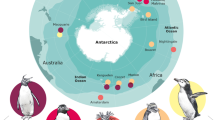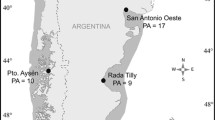Abstract
We analysed the genetic diversity of Melicertus kerathurus (Penaeidae), a commercially valuable penaeid shrimp that is distributed in the Mediterranean Sea and eastern Atlantic Ocean. We examined the polymorphism of a 494 bp DNA segment of the mitochondrial COI region in 173 individuals, sampled in nine Mediterranean and two Atlantic samples, covering the whole range of the species from the tropical waters of the Gulf of Guinea to the eastern part of the Mediterranean Sea. The mean nucleotide and haplotype diversities were π = 0.00275 and h = 0.718, respectively, for the global data set, with the highest values occurring in the African samples and the lowest in the Adriatic Sea. A clear sample differentiation was found (F st = 0.194), but this did not reflect a geographical pattern and there were only faint traces of an Atlantic–Mediterranean subdivision. Mismatch analysis and a high significant negative value of Tajima’s D suggested that M. kerathurus is not at mutation drift-equilibrium, but underwent a recent expansion after a period of low effective sample size. A postglacial recolonisation of the Mediterranean from an Atlantic refuge could be hypothesised based on these data.




Similar content being viewed by others
References
Holthuis LB (1980) Shrimps and prawns of the world. An annotated catalogue of species of interest to fisheries. FAO Fish Synop (125) 1:271
Dall W, Hill BJ, Rothlisberg PC, Staples G (1990) The biology of the Penaeidae. Adv Mar Biol 27:1–489
Mattoccia M, La Rosa G, De Mattheis E, Coboldi-Sbordoni M, Sbordoni V (1987) Patterns of genetic variability in Mediterranean populations of Penaeus kerathurus (Crustacea Decapoda). In: Tiews K (ed) Selection, hybridization and genetic engineering in aquaculture. Heenemann-Verlag, Berlin, pp 131–142
Hedgecock D, Tracey ML, Nelson K (1982) Genetics. In: Abele LG (ed) The biology of Crustacea. Academic, New York, pp 284–403
Benzie JAH (2000) Population genetic structure in penaeid prawns. Aquac Res 31:95–119
Brooker AL, Benzie JAH, Blair D, Versini JJ (2000) Population structure of the giant tiger prawn Penaeus monodon in Australian waters, determined using microsatellite markers. Mar Biol 136:149–157
Benzie JAH, Ballment E, Forbes AT, Demetriades NT, Sugama K, Haryanti Moria S (2002) Mitochondrial DNA variation in Indo-Pacific populations of the giant tiger prawn, Penaeus monodon. Mol Ecol 11:2553–2569
Tzeng TD, Yeh SY, Hui CF (2004) Population genetic structure of the kuruma prawn (Penaeus japonicus) in East Asia inferred from mitochondrial DNA sequences. ICES J Mar Sc 61:913–920
Borsa P, Naciri M, Bahri L (1997) Zoogeographie infra-specifique de la Mer Mediterranee. Vie et Milieu 47:295–305
Kotoulas G, Magoulas A, Tsimenides N, Zouros E (1995) Marked mitochondrial DNA differences between Mediterranean and Atlantic populations of the swordfish, Xiphias gladius. Mol Ecol 4:473–481
Bargelloni L, Alarcon JA, Alvarez MC, Penzo E, Magoulas A, Palma J, Patarnello T (2005) The Atlantic-Mediterranean transition: discordant genetic patterns in two seabream species, Diplodus puntazzo (Cetti) and Diplodus sargus (L.). Mol Phyl Evol 36:523–535
Lo Brutto S, Arculeo M, Parrinello N (2004) Congruence in genetic markers used to describe Mediterranean and Atlantic populations of European hake (Merluccius merluccius L. 1758). J Appl Ichthyol 20:81–86
Lemaire C, Versini JJ, Bonhomme F (2005) Maintenance of genetic differentiation across a transition zone in the sea: discordance between nuclear and cytoplasmatic markers. J Evol Biol 18:70–80
Quesada H, Beynon CM, Skibinski DOF (1995) A mitochondrial DNA discontinuity in the mussel Mytilus galloprovincialis Lmk: pleistocene vicariance biogeography and secondary intergradation. Mol Biol Evol 12:521–524
Zane L, Ostellari L, Maccatrozzo L, Bargelloni L, Cuzin-Roudy J, Buchholz F, Patarnello T (2000) Genetic differentiation in a pelagic crustacean (Meganyctiphanes norvegica: Euphausiacea) from the North East and the Mediterranean Sea. Mar Biol 136:191–199
Stamatis C, Triantafyllidis A, Moutou KA, Mamuris Z (2004) Mitochondrial DNA variation in Northeast Atlantic and Mediterranean populations of Norway lobster, Nephrops norvegicus. Mol Ecol 13:1377–1390
Diaz-Almela E, Boudry P, Launey S, Bonhomme F, Lapegue S (2004) Reduced female gene flow in the European flat oyster Ostrea edulis. J Hered 95:510–516
Patarnello T, Volckaert FAM, Casthilo R (2007) Pillars of Hercules: is the Atlantic–Mediterranean transition a phylogeographical break? Mol Ecol 16:4426–4444
Folmer O, Black M, Hoeh W, Lutz R, Vrijenhoek R (1994) DNA primers for amplification of mitochondrial cytochrome c oxidase subunit I from diverse metazoan invertebrates. Biomol Mar Biol Biotechnol 5:294–299
Rozas J, Sánchez-DelBarrio JC, Messeguer X, Rozas R (2003) DnaSP, DNA polymorphism analyses by the coalescent and other methods. Bioinformatics 19:2496–2497
Excoffier L, Smouse P (1994) Using allele frequencies and geographic subdivision to reconstruct gene genealogies within a species. Molecular variance parsimony. Genetics 136:343–359
Schneider S, Roessli D, Excoffier L (2000) Arlequin ver. 2.000: a software for population genetic data analysis, genetics and biometry laboratory. University of Geneva, Geneva
Felsenstein J (1995) Phylip (Phylogeny Inference Package), version 3.57c. Department of Genetics, University of Washington, Seattle
Excoffier L, Smouse P, Quattro JM (1992) Analysis of molecular variance inferred from metric distances among DNA haplotypes: application to human mitochondrial DNA restriction data. Genetics 131:479–491
Mantel N (1967) The detection of disease clustering and generalized regression approach. Cancer Res 27:209–220
Belkhir K, Borsa P, Chikhi L, Raufaste N, Bonhomme F (2001) GENETIX 4.02, Logiciel Sous Windows TM Pour la Génétique Des Populations. Laboratoire Génome, Populations, Interactions, Université de Montpellier II, Montpellier
Rogers AR, Harpending HC (1992) Population growth makes waves in the distribution of pairwise genetic differences. Mol Biol Evol 9:552–569
Tajima F (1989) Statistical method for testing the neutral mutation hypothesis by DNA polymorphism. Genetics 123:585–595
Buklin A, Wiebe PH (1998) Low mitochondrial diversity and small effective population sizes of the copepods Calanus finmarchicus and Nannocalanus minor: possible impact of climatic variation during recent glaciation. J Hered 89:383–392
Maggio T, Lo Brutto S, Cannas R, Deiana AM, Arculeo M (2009) Environmental features of deep-sea habitat linked to the genetic population structure of a crustacean species in the Mediterranean Sea. Mar Ecol doi:10.1111/j.1439-0485.2008.00277.x
Inoue N, Watanabe H, Kojima S, Sekiguki H (2007) Population structure of Japanese spiny lobster Panulirus japonicus inferred by nucleotide sequence analysis of mithocondrial COI gene. Fish Res 73:550–556
Watterson GA (1984) Allele frequencies after a bottleneck. Theoret Pop Biol 26:387–407
Rogers AR (1995) Genetic evidence for a Pleistocene population explosion. Evolution 49:608–615
Conides A, Glamuzina B, Jug-Dujakovic J, Papaconstantinou C, Kapiris K (2006) Age, growth, and mortality of the kamarote shrimp, Melicertus kerathurus (Forskal, 1775), in the east Ionian sea (Western Greece). Crustaceana 79:33–52
Lumare F, Scordella G (2001) Biological cycle, growth and reproduction of the Penaeid shrimp Penaeus (Melicertus) keraturus of the Adiatic coasts. In: Proc Int Workshop Stato della Pesca e Dinamica di Popolazione del Gambero Mediterraneo Penaeus (Melicertus) kerathurus in Alcune Aree della Costa Adriatica, Lecce, Italy, 16 March 2001, pp 2–14 (in Italian)
Acknowledgments
This research was supported by Università di Palermo (ex 60%), CORI and MiPAF projects. We are grateful to V. Balsamo, A. Belluscio, L. Cannizzaro, J.D. Durand, B. Adépo-Gourène, H. Kara, F. Maltagliati, M. Koutrakis and F. Lumare for collecting samples.
Author information
Authors and Affiliations
Corresponding author
Appendix: Polymorphic nucleotide sites in a partial cytochrome c oxidase gene of 51 haplotypes
Appendix: Polymorphic nucleotide sites in a partial cytochrome c oxidase gene of 51 haplotypes
Identity with the top reference sequence is indicated by a dot.

Rights and permissions
About this article
Cite this article
Pellerito, R., Arculeo, M. & Bonhomme, F. Recent expansion of Northeast Atlantic and Mediterranean populations of Melicertus (Penaeus) kerathurus (Crustacea: Decapoda). Fish Sci 75, 1089–1095 (2009). https://doi.org/10.1007/s12562-009-0131-z
Received:
Accepted:
Published:
Issue Date:
DOI: https://doi.org/10.1007/s12562-009-0131-z




